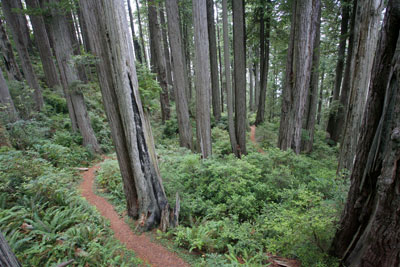|
Redwoods, beach highlight Damnation Trail
 |
Zach Urness/Daily Courier
Damnation Creek Trail. |
Winding through old-growth redwoods and providing access to a hidden cove along the ocean, Damnation Creek Trail is the best place to explore the magic of Northern California’s redwood coast. Here’s a photo gallery of the redwoods and the ocean coast, along with more information on the hike itself.o o o oBy Zach Urness of the Daily CourierDamnation!The first time I heard about a trail that made use of that fun, old-timey word, I knew I had to check it out.The fact that Damnation Creek Trail — as the official title goes — drops through old-growth redwoods to a remote ocean beach made it even more appealing.Damnation!But it wasn’t until I hiked this 4.4-mile trail that I discovered, much to my surprise, that this fairly unknown path is the best way to explore the Crescent City, Calif., area.The reason is simple.The vast majority of people that head to the Northern California Coast experience the redwoods and beach separately. They hike popular, crowded spots such as Stout Grove for the redwoods. Then they jump into their cars and use turnouts and parks along Highway 101 for views of the beach.And that’s fine.But Damnation Creek takes all those highlights, the old-growth monsters and rugged ocean beach, and combines them into one magic section of trail.The ocean’s blue lights up giant ferns and pink and purple rhododendron blossoms on clear days as the smells of salt and wood waft together.Damnation!It always begins the same way.Three times this year I’ve had friends and family arrive in Grants Pass, and in all three instances they’ve wanted to see the redwood coast.So we jump into the car and, after a passing through Crescent City, stop at mile marker 16 on Highway 101.The pullout on the right side of the highway is inconspicuous. Unlike the tourist mecca of Jedediah Smith Redwoods State Park, Damnation Creek Trail begins without much fanfare. Just a small parking lot, trailhead sign and, of course, trees the size of Saturn Rockets.The first .7 miles wind through a spectacular grove of 300-foot monsters in the Del Norte section of the Redwood National and State Parks system. This patchwork collection of parks protect what remains of these old-growth Northern California forests, only 5 percent of which remain unchanged.For that first half mile you can hear cars rumbling along Highway 101, but after passing a junction with the coastal trail, and following the trail as it drives down toward the ocean, you begin to sense that magic immersion which occurs in the silence of ancient forests.The trees are dark brown and ash white, and twist like Gothic pillars above a lush floor of ferns, mushrooms and banana slugs.As the trail drops closer to the ocean, the landscape begins to change. The redwood forest gives way to a more coastal setting with brighter, emerald green plants and gnarled trees like Sitka spruce and manzanitas.After crossing a large footbridge, the trail ends in a meadow with a stunning ocean overlook. Massive cliffs overhang the ocean and waves crash against rocks guarding the beach.This is a turnaround point for some, but my favorite part of the trail is exploring this hidden cove.There’s a trail that leads to the beach — located near the overlook — and if the tide is low enough, there’s any number of tide pools to explore.If the tide is higher, I’ll walk along the beach and explore the cliffs or play “driftwood baseball.” It’s a game that involves finding a piece of driftwood and hitting rocks into sea.The pieces of driftwood are such perfect sizes, and the satisfaction of smacking rocks into the ocean’s salty breeze so deep, that I’m convinced people were playing this game thousands of years before baseball was invented.You can spend a full day exploring the nooks and crannies of Damnation Creek Trail, whether in the redwoods or along the ocean beach. But of course you’ll eventually have to climb 1,100 feet back uphill to your car, a trek exhausting enough to make you say:Damnation!o o o oNotes: The history of Damnation Creek’s name is imperfect, but the best evidence suggests that it’s derived from settlers who found the going fairly rough there during the 1800s. Even Jedediah Smith, for whom the state park and Smith River is named, struggled during his 1828 expedition through the area. Damnation, indeed. ... Those who decide to explore the beach at the end of Damnation Creek Trail should be weary, as high tides and sneaker waves can be extremely hazardous to those who get caught in the water.
| |
|





